How to find out what is taking up disk space. How to find out what is occupied by disk space using the free program WinDirStat
When working with a computer, the issue of shortage often arises physical memory. This is especially true if it is necessary to preserve big file to your hard drive or install a bulky program or game. And, if there is not enough memory, the question arises - what took up space. In this article I will talk about a program that will help you find out what is occupied by disk space. It's called WinDirStat, and below you can download it and get instructions for working with it.
WinDirStat is remarkable the following features and advantages:
- It is in Russian and completely free.
- Allows you to view volume statistics by directory and file type.
- Displays visual statistics, which is very convenient in practice.
- Allows you to easily manage files and folders directly from the program interface.
- It works quite quickly and easily scans large directories.
- Supports all types hard drives, as well as removable storage devices.
How to find out what is taking up disk space
Open the program after installation. You will see a small window in which you need to select which part of the computer you want to find out what is occupied by disk space:
- You can select an entire hard drive - to do this, turn on the “All local drives” radio button.
- You can select one or more disks - to do this, turn on “Individual disks” and select the desired disks.
- Or you can select a specific folder - to do this, you need to put a dot on the “Directory” radio button, and then click on the browse button and select the desired folder.
The scanning will take some time. The larger the catalog you have chosen, the longer the scanning will take. Wait for it to complete. And as a result, you will see such a picture.
Let's take a closer look at what's what, and how to find out what is occupied by disk space.
So, the section at the top left displays a list of all found directories and shows in a table their weight in megabytes and percentages. This data can be easily sorted.
The top right section displays the amount of used space by file type.
And the bottom section, the most convenient and interesting, displays visual statistics of folders by volume. Here you can easily find out what is occupied by disk space, simply by seeing with your own eyes how much space a particular directory requires.
By clicking on any colored area, you can see the selected directory in the section at the top left.
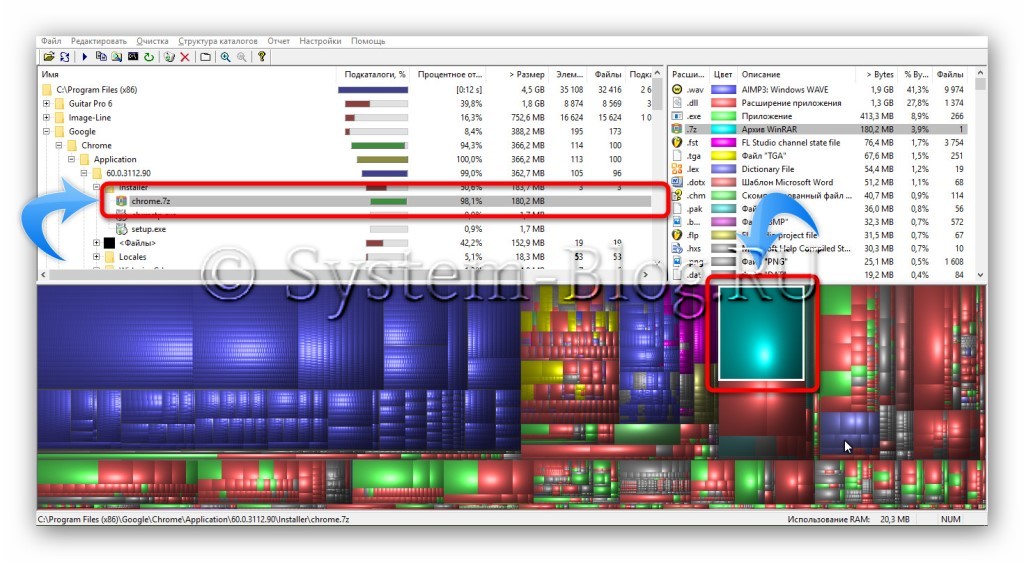
Several advisors. And then, at one fine moment, the system reports that the disk has run out of free space. The disk size is 150 GB, about 20 GB were occupied. Installed terminals they begin to freeze and it becomes impossible to work. I start looking for the cause of the disk fullness, I clean it CCleaner program- manages to free up about 3 gig. I understand that the problem is related to the operation of MT4 terminals, but in its folders with using Total Commander can't find large files.
It was this problem that forced me to choose a program that would report in a convenient form about file size in one directory or another. And I settled on a small free program Scanner, which allowed me to find the “bloated” log file of one of the terminals within a few minutes. Everything turned out to be quite simple - it caused an error in its operation and the terminal on which it was installed wrote a line in its operation to the advisor’s work log on every tick. And in the program Total Commander this file was “stupidly” not displayed!
It is very popular among Forex traders. User-friendly interface, rich functionality make it a leader among similar programs. You can download MetaTrader 4 on the website of the company with which you plan to cooperate. The program itself weighs less than 1 MB, and its installation takes just a couple of minutes. After installation, the folder with terminal files will weigh several tens of megabytes, and it can be located either on system disk C:\ and on other, non-system drives, depending on which directory the user specified when installing the application. In addition to the root folder of the MetaTrader 4 terminal, another folder is created on the computer - the so-called data directory (folder \MQL4\). Starting with build 600 of the MetaTrader 4 terminal, the structure of the program installation has changed and, regardless of where the terminal is installed, the data directory during installation is by default placed on the system drive C:\. Accordingly, all logs of the operation of advisors, scripts or indicators will be written to the system drive C:\. That is why we recommend not installing MT4 terminals on the system disk (more details), but launching the program itself - in this case, the data directory will be located in the MetaTrader 4 installation directory.
In addition to files of advisors, scripts, indicators, log files are also recorded in the data directory. The MetaTrader 4 program log file is a history where every action performed by a trader, advisor, indicator, and even broker is recorded. Depending on trading activity, this history can take up several hundred megabytes, or even gigabytes of hard drive space. Log files become especially inflated when there are errors in the work of experts, and after several years the platform begins to noticeably freeze. Moreover, the more space occupied on the disk (and this is, as a rule, the system disk), the more the performance of not only the terminal, but the system as a whole is slowed down. From time to time you should clean up the log files by deleting them. You can remove them manually without harming the performance of the platform. But to do this, the first thing you need to do is determine their location.
A program for searching large files - Scanner.
The search may be complicated by the fact that the folder in which the data needed for deletion is located may be hidden, or the path to it will be very long (as is the case if the data directory is located on the system drive). But there is analysis program contents of all disks, including removable media. It's called Scanner, and you can download it absolutely free. After starting the program, a window will appear where you need to select a disk for analysis. After selecting, the scan will start, the result of which will appear in the form of a diagram with all the folders and files of the analyzed disk:
Rice. 1. Disk structure in the form of a diagram in the Scanner program.
The central circle (lilac color) is the entire volume of the disk; the part occupied by information is painted in a darker color. Outside the central circle, the diagram is already divided into segments corresponding to the weight of folders on the disk, then there is a division into segments that show how much space subfolders take up, and so on until final files. By clicking on a sector of the diagram, you can move deeper into the disk to obtain information about subfolders and their contents:
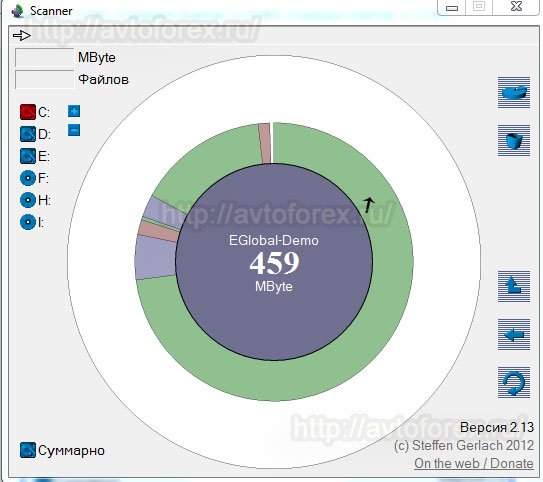
Rice. 2. View the size and location of subfolders on the disk in the Scanner program.
The path to the folder/file will be indicated in the line at the top of the program window. When detecting "heavy" files that do not carry important information, the trader can delete them, thereby freeing up disk space. To do this you need to call context menu by right-clicking on the selected segment. In addition to the Remove task, functions such as Recycle (deleting to the recycle bin), Open (open a folder in Explorer), Rescan (rescan), Zoom (enlarge the diagram, more precisely the selected segment), Hide (hide the segment) will be available here. . You can safely clear the following subfolders of the trading terminal:
- - \logs\ - terminal operation logs for each day are stored here;
- - \mailbox\ - all information and messages from mailbox terminal;
- - \experts\logs\ - here you can find information about the work of advisors and scripts;
- - \tester\history\ - information is stored here in the form of the history of the tester;
- - \tester\logs\ - and here the work logs are located.
Before cleaning out these or other folders, make sure you really don't need them!
And one more thing - the program can and should be used not only to clean up the “garbage” that appears when operating MT4 terminals, but also to view information about what any hard disks installed on the computer. And do you know how much garbage you can “dig up” using this wonderful program - Scanner?
Download free Scanner program for rate occupied space on hard drives computer you can on this page.
If you are using SSD drive or HDD small volume, then you probably run out of disk space from time to time. Typically, in such cases, you have to manually go through the folders and examine their contents in order to determine what can be deleted to free up space. Fortunately, this process can be greatly simplified and speeded up. In this article we will talk about how to quickly find out what is taking up disk space.
If you need to find out what's taking up disk space, the easiest way to do this is to use the free WinDirStat program. This program analyzes the contents of the disk and builds a visual map with which you can easily detect the files and folders that take up the most space on the disk. You can download the WinDirStat program.
After launch WinDirStat programs A window will appear in which you need to indicate what exactly you want to analyze. If you don’t know where exactly on the disk the files that take up a lot of space are located, then simply select the disk and click on the “OK” button.
If you know a folder that takes up a lot of space, you can select it right away. In this case, WinDirStat will only analyze files in the folder you select.
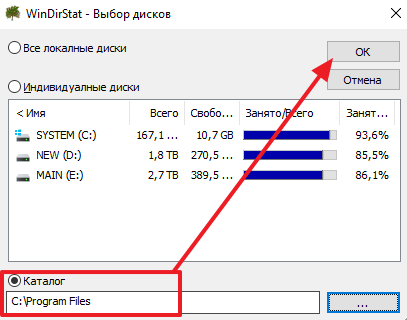
After selecting a disk or folder, you need to wait until the program finishes analyzing. In the window title you can see how many percent are left.
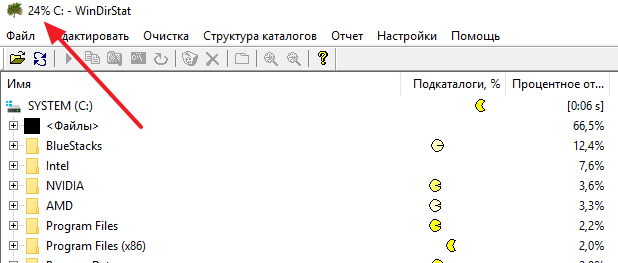
After completing the analysis, you can begin working with the WinDirStat program. At the top left of the program interface there will be a list of folders. In this case, to the right of each folder it will be indicated how much space this folder takes up in gigabytes and percentage. Thanks to this, you can quickly find the folders that take up the most disk space.
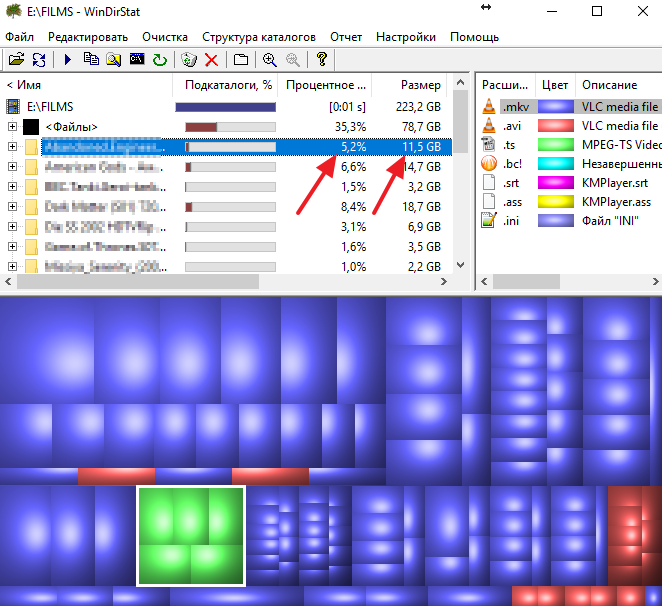
Statistics on file types will be shown in the upper right part of the program window. In this case, on the right it will be indicated how much space which files take up. Also indicated here is the color that is used to indicate this type files on the map below.
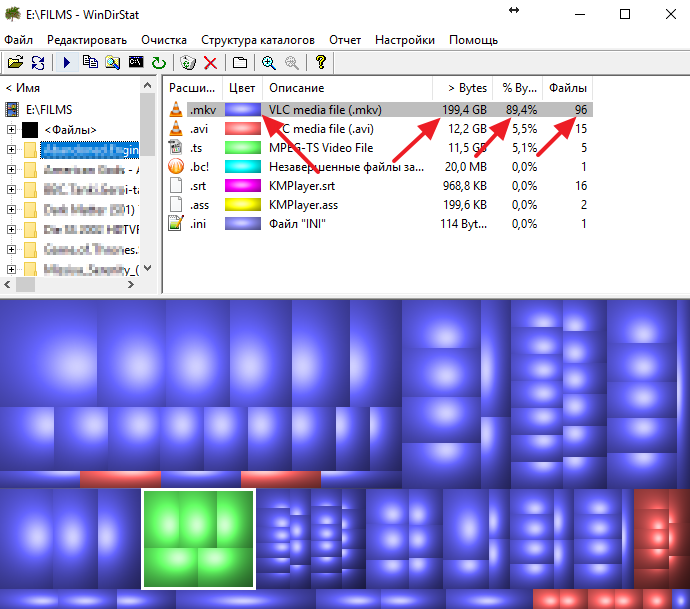
The most helpful information, which is available in the WinDirStat program, is located at the bottom of the window. Here is a map that makes it easy to find the files that take up the most disk space. By clicking on any of the files on the map, you will see this file in the folder list.
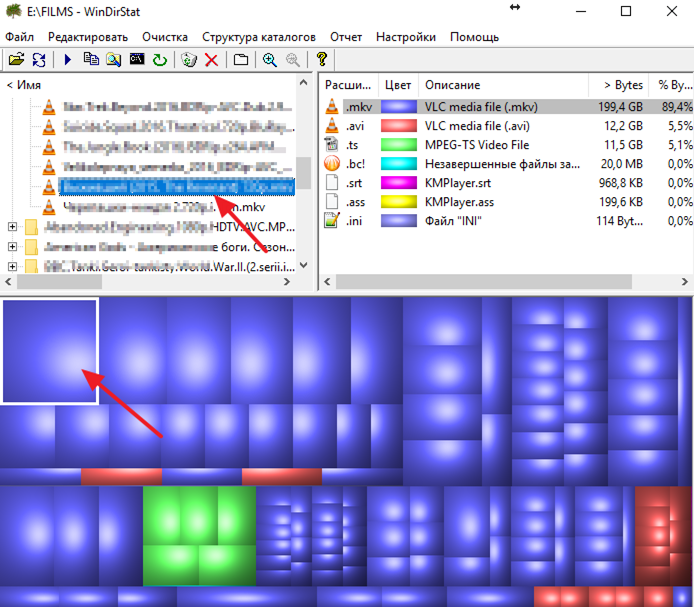
If you find files you don't need, you can delete them directly from the WinDirStat program. To do this you need to click right click mouse over the file in the directory list and select “Delete to Trash” or “Delete permanently”.
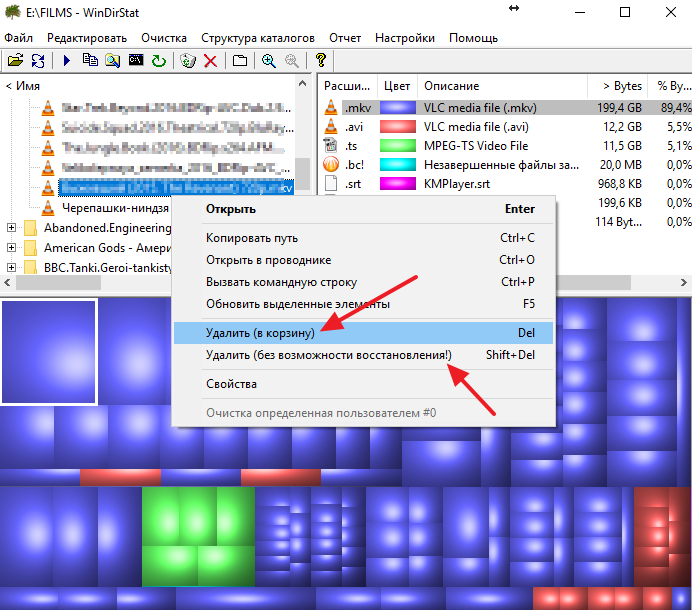
It should be noted that deleting files to the Recycle Bin allows you to later restore the file, but this deletion method does not free up disk space. In this case, space is freed only after emptying the Trash. In order to immediately release busy with file place use permanent deletion.
If the WinDirStat program for some reason does not suit you, then you can try using others similar programs. For example, you can use programs such as Free Disk Analyzer, Disk Savvy, TreeSize Free or SpaceSniffer.
Many users are familiar with the situation when there is almost no memory left on the computer’s hard drive. free space. What to do in this case? There are two obvious solutions to this problem: buy new hard disk or free up space on the one currently in use. Experience shows that a new hard drive tends to clog up again quite quickly. various information. It is better to choose the second way - to clear space on the existing hard drive: delete unnecessary files and move files that occupy the maximum disk space to another location. How can I see what the hard drive is doing? For this purpose, you can use the Disk Usage Analyzer program, which will perform.
Not all novice users know that if you decide to purchase a new hard drive, then before you start using it, the drive needs to be formatted, and also divided into partitions and logical drives. Often the disk is divided into two partitions - primary and secondary. In the main section there is operating system, V additional section- all other files. Partitions create logical drives that have their own names, for example, drive C, drive D, and so on. After dividing the disk into partitions and logical drives, formatting is performed, that is, the logical layout of the entire disk space.
On physical level The hard drive is divided into tracks, which in turn are divided into sectors. A sector is the minimum physical volume of a disk to accommodate data. Typically, its size is 512 bytes. When a disk is logically partitioned, it creates separate areas, which consist of one or more sectors. They are called clusters. The number of sectors in the cluster, and therefore its size, can be adjusted when formatting the disk. The size of the cluster affects the volume that files occupy and the speed of the system. This is because if the file size smaller size cluster, then nothing more can be added to this cluster, and disk space is wasted irrationally. On the other hand, if the cluster size is small, then the file is written to several adjacent clusters, and if there are not enough adjacent clusters, then the remaining part of the information is written to the nearest free cluster. In this case, it increases the time spent on “assembling” the file from individual clusters, and the speed of data exchange with hard drive decreases.







